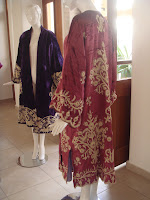


Randa Ali Ahmad
exhibition: The Crisis
at the Phoenicia hotel annex Beirut, Lebanon
until 30 dec 08
The Lebanese artist has an eye for using raw spaces in her exhibits with a concrete wall, holes and wires all apparent. Randa Ali Ahmad has given the public a view of her latest artwork on canvas with acrylic and textures. She has chosen to express herself on the financial crisis of autumn 08. With a red line as a matrix, she has painted portraits of men in 30 canvas in different aspects of what she believes is hope after the money boom and crash.
The first room has men in suits and a tie as a symbol of responsibility and yellow as close as a rope for hanging can get. They have no eyes. They are looking away. The second room a money painting and hundred dollar bills. Men have expressions, they show a variety of poses on human potentials. The last room the explosion of emotion with contractions, ease, speed, fear, pride...
The element of hope she tried to inject in that crisis is surely the human side to the cold, ruthless power of coins and money.
It is ready for your interpretation and your understanding.












